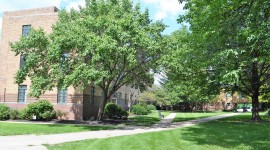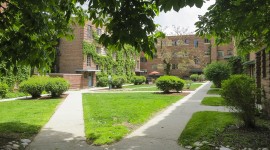FHA-Approved Neighborhood
The 1931 President’s Conference on Home Building and Home Ownership led to substantial reforms in housing for middle and lower middle income Americans, and resulted in the passage of the National Housing Act of 1934, creating the Federal Housing Administration (FHA). These reforms were guided by the “Neighborhood Unit” concept (introduced by Clarence Perry of the Russell Sage Foundation), a revival of Riverside, Illinois as an ideal of American suburban design, and the synthesis of Olmstedian (curvilinear) and Garden City principles (hierarchy of roads, superblock, restrictions, etc.)
Long curvilinear blocks avoided four-way intersections in favor of cul-de-sacs,and circles. Designers grouped modest houses of similar style and scale and set them back a uniform distance from tree-lined streets, with nearby access to trolley or bus lines. Garden Apartment communities featured multiple buildings of similar style and scale arranged within a garden-like superblock. Similar to the Country Club districts, deed restrictions and protective covenants prohibited “non-conforming” uses and resulted in a cohesive, even homogenous, residential village in a park-like setting.


















